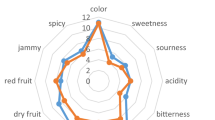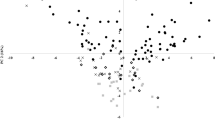Abstract
The aim of this study was to elucidate the Korean consumers’ aroma preference on wines. For this, a sensory test on 6 commercial red wines (5 imported and 1 domestic) was conducted by 250 panels and the volatile compounds of those wines were analyzed by gas chromatography-mass spectrometry. Sample 1 obtained the highest mean aroma acceptability score and analysis of volatile compounds revealed that it retained many kinds of esters and alcohols compared to other wines (including 2 acetate esters, 6 ethyl esters, 3 other esters, and 5 alcohols, mostly giving fruity aroma). Sample 1 was made by blending 2 varieties of grapes and this brewing technology might give a preferred aroma balance. The domestic wine, sample 2, made of ‘Campbell Early’ grape earned relatively higher acceptability score (2nd ranked), being considered its strong grape aroma. In the lower score group, higher concentrations of isoamyl alcohol, 1-isothiocyanto-propane, and volatile phenol were detected and their strong grassy or fatty odor might affect the lower sensory result. Strategies for production of consumer-preferred wines were suggested.
Similar content being viewed by others
References
Korea Alcohol and Liquor Industry Association. Market Trend of 2007’s Korea Alcoholic Beverages, Korea 28: 45–46 (2008)
Rapp A, Mandery H. Wine aroma. Cell. Mol. Life Sci. 42: 873–884 (1986)
Jackson DI, Lombard PB. Environmental and management practices affecting grape composition and wine quality-a review. Am. J. Enol. Viticult. 44: 409–430 (1993)
Rocha SM, Rodrigues F, Coutinho P, Delgadillo I, Coimbra MA. Volatile composition of Baga red wine: Assessment of the identification of the would-be impact odourants. Anal. Chim. Acta 513: 257–262 (2004)
Santos JP, Arroyo T, Aleixandre M, Lozano J, Sayago I, García M, Fernández MJ, Arés L, Gutiérrez J, Cabellos JM, Gil M, Horrillo MC. A comparative study of sensor array and GC-MS: Application to Madrid wines characterization. Sensor. Actuat. B-Chem. 102: 299–307 (2004)
Mamede MEO, Cardello HMAB, Pastore GM. Evaluation of an aroma similar to that of sparkling wine: Sensory and gas chromatography analyses of fermented grape musts. Food Chem. 89: 63–68 (2005)
Yook C, Seo MH, Lee JW, Kim YH, Lee KY. Quality properties of wines fermented with domestic new different grapes. Korean J. Food Sci. Technol. 40: 633–642 (2008)
Lee SJ, Lee JE, Kim HW, Kim SS, Koh KH. Development of Korean red wines using Vitis labrusca varieties: Instrumental and sensory characterization. Food Chem. 94: 385–393 (2006)
Kim JS, Kim SH, Han JS, Yoon BT, Yook C. Effects of sugar and yeast addition on red wine fermentation using ‘Campbell Early’. Korean J. Food Sci. Technol. 31: 516–521 (1999)
Park WM, Park HG, Rhee SJ, Lee CH, Yoon KE. Suitability of domestic grape, cultivar ‘Campbell’s Early’, for production of red wine. Korean J. Food Sci. Technol. 34: 590–596 (2002)
Lee JE, Hong HD, Choi HD, Shin YS, Won YD, Kim SS, Koh KH. A study on the sensory characteristics of Korean red wine. Korean J. Food Sci. Technol. 35: 841–848 (2003)
Alejandro C, Elena F. Volatile composition of Mencia wines. Food Chem. 90: 357–363 (2005)
Cabrita MJ, Freitas AMC, Laureano O, Borsa D, Stefano RD. Aroma compounds in varietal wines from Aletejo, Portugal. J. Food Compos. Anal. 20: 375–390 (2007)
Stephane B, Pascal C. Rapid headspace solid-phase microextraction/gas chromatographic/mass spectrometric assay for the quantitative determination of some of the main odorants causing off-flavours in wine. J. Chromatogr. A 1141: 1–9 (2007)
Alvelos H, Cabral JAS. Modeling and monitoring the decision process of wine tasting panelists. Food Qual. Prefer. 18: 51–57 (2007)
Pérez-Prieto LJ, López-Roca JM, Gómez-Plaza E. Differences in major volatile compounds of red wines according to storage length and storage conditions. J. Food Compos. Anal. 16: 697–705 (2003)
Lorenzo C, Pardo F, Zalacain A, Alonso GT, Salinas MR. Complementary effect of ‘Cabernet Sauvignon’ on Monastrell wines. J. Food Compos. Anal. 21: 54–61 (2008)
Matthews A, Grimaldi A, Walker M, Bartowsky B, Grbin P, Jiranek V. Lactic acid bacteria as a potential source of enzymes for use in vinification. Appl. Environ. Microb. 70: 5715–5731 (2004)
Garde-Cerdán T, Ancín-Azpilicueta C. Review of quality factors on wine aging in oak barrels. J. Food Sci. Technol. 17: 438–477 (2007)
Maicas S, Gil JV, Pardo I, Ferrer S. Improvement of volatile composition of wines by controlled addition of malolactic bacteria. Food Res. Int. 32: 491–496 (1999)
Agouridis N, Kopsahelis N, Plessas S, Koutinas AA, Kanellaki M. Oenococcus oeni cells immobilized on delignified cellulosic material for malolactic fermentation of wine. Bioresource Technol. 99: 9017–9020 (2008)
Antonell A, Castellari L, Zambonelli C, Carnacini A. Yeast influence on volatile composition of wines. J. Agr. Food Chem. 47: 1139–1144 (1999)
Clarke RJ, Bakker J. Contents and Sensory Evaluation Data. Wine Flavor Chemistry. Blackwell Publishing, Oxford, UK. pp. 142–177 (2004)
Cañas PMI, Romero EG, Alonso SG, Herreros MLLP. Changes in the aromatic composition of Tempranillo wines during spontaneous malolactic fermentation. J. Food Compos. Anal. 21: 724–730 (2008)
Margalit Y. Blending. Concepts in Wine Technology. A Wine Appreciation Guild Book, San Francisco, CA, USA. pp. 118–121 (2004)
Atanasova B, Thomas-Danguin T, Chabanet C, Langlois D, Nicklaus S, Etiévant P. Perceptual interactions in odour mixtures: Odour quality in binary mixtures of woody and fruity wine odorants. Chem. Sens. 30: 209–217 (2005)
Author information
Authors and Affiliations
Corresponding author
Rights and permissions
About this article
Cite this article
Yoo, KS., Kim, J.E., Moon, J.S. et al. Evaluation of a volatile aroma preference of commercial red wines in Korea: Sensory and gas chromatography characterization. Food Sci Biotechnol 19, 43–49 (2010). https://doi.org/10.1007/s10068-010-0006-1
Received:
Revised:
Accepted:
Published:
Issue Date:
DOI: https://doi.org/10.1007/s10068-010-0006-1




